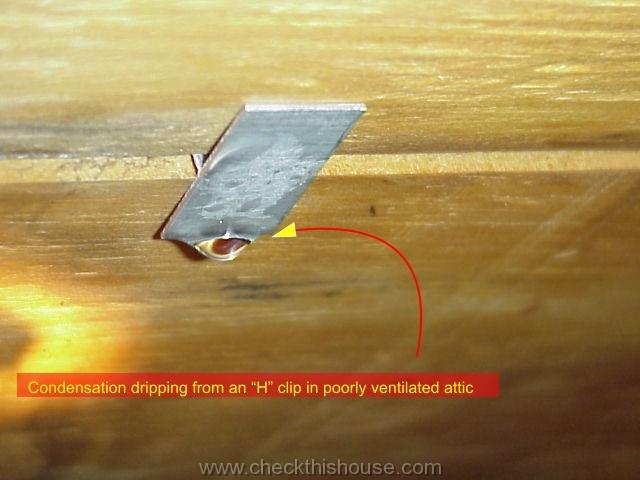Attic moisture is a very common problem in cold climates.

 Let’s answer the attic moisture question below (from one of the website visitors): I have an extreme amount of attic moisture, I recently had my roof re-shingled and had the roofer add 2 more vents for better ventilation.
Let’s answer the attic moisture question below (from one of the website visitors): I have an extreme amount of attic moisture, I recently had my roof re-shingled and had the roofer add 2 more vents for better ventilation.
There is a build up of frost in certain areas of my roof, it has been an extremely cold winter, would lack of insulation cause this and how deep should the insulation be?
 Lack of insulation on the attic floor (house ceiling) is definitely one of the most important reasons for attic moisture resulting from migration of warm air into the attic, and moisture condensation on the roof framing / decking.
Lack of insulation on the attic floor (house ceiling) is definitely one of the most important reasons for attic moisture resulting from migration of warm air into the attic, and moisture condensation on the roof framing / decking.
Although, properly designed attic ventilation would most likely remove this warm air before it starts elevating attic moisture levels and condensing. However, we’re still loosing expensive energy.
 Installation of additional roof vents helps to control attic moisture under one condition – they have to be distributed properly in order to maintain air circulation between the lower and upper section of the attic, or sideways (between gables). Those two additional roof vents (I’m assuming on top of the roof) won’t help much if there’s nothing or not enough vents (air intakes) along the bottom edges of your roof.
Installation of additional roof vents helps to control attic moisture under one condition – they have to be distributed properly in order to maintain air circulation between the lower and upper section of the attic, or sideways (between gables). Those two additional roof vents (I’m assuming on top of the roof) won’t help much if there’s nothing or not enough vents (air intakes) along the bottom edges of your roof.
Depending on the roof design, installation of “lower” vents could become a challenge – the best example would be a roof with no overhang /soffits to accommodate vents. In such case, attic moisture control can be performed utilizing the following 3 passive vent options:
- Drip edge vents installed along the bottom edge of the roof / right above the gutter
- A few regular vents on the roof surface, within 1/3 of the distance between the bottom and top section of the roof plane (not an ideal situation but sometimes the only one)
- Hip vents – the same as a ridge vent (almost)
 Unfortunately, any significant amount of snow and / or ice accumulating at the lower portion of the roof, inside the gutter (for a drip edge vent) will most likely compromise the air flow and prevent attic moisture removal. It sounds like there’s no solution… well, if you combine a humidistat controlled attic power vent, with any of the above described passive vents, you’ll have much better chance of removing attic moisture and preventing frost and condensation from building up in your attic.
Unfortunately, any significant amount of snow and / or ice accumulating at the lower portion of the roof, inside the gutter (for a drip edge vent) will most likely compromise the air flow and prevent attic moisture removal. It sounds like there’s no solution… well, if you combine a humidistat controlled attic power vent, with any of the above described passive vents, you’ll have much better chance of removing attic moisture and preventing frost and condensation from building up in your attic.
The insulation issue / how deep the attic insulation should be to minimize attic moisture problem?
It all depends on your geographical location and type of the insulation installed. The most commonly used for the attic floor are blown-in types of insulation: cellulose and fiberglass.
 For attic insulation amounts and sample calculations please visit – attic ceiling insulation
For attic insulation amounts and sample calculations please visit – attic ceiling insulation
You can also find more information about your attic issues (including more about attic moisture) on my website under “Attic”



Comments are closed.